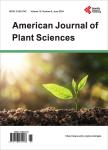Mycosphaerella areola—The Teleomorph of Ramularia areola of Cotton in Brazil, and Its Epidemiological Significance
Mycosphaerella areola—The Teleomorph of Ramularia areola of Cotton in Brazil, and Its Epidemiological Significance作者机构:A Instituto Agronomico do Paraná—IAPAR Londrina Brazil Instituto Mato-Grossense do Algodao (IMA) Primavera do Leste—MT Tropical Agriculture—FAMEVZ/UFMT Cuiabá Brazil Embrapa Cenargen Brasilia Brazil
出 版 物:《American Journal of Plant Sciences》 (美国植物学期刊(英文))
年 卷 期:2016年第7卷第10期
页 面:1415-1422页
学科分类:1002[医学-临床医学] 100214[医学-肿瘤学] 10[医学]
主 题:Gossypium hirsutum Ramularia Leaf Blight Sexual Morph ITS rDNA Sequence Analysis
摘 要:While Ramularia leaf blight of cotton caused by Ramularia areola is of top most importance for Brazil, information is lacking regarding the survival mechanism of this pathogen during the cotton-free period. The teleomorph of R. areola is expected to belong to the genus Mycosphaerella. In the present study attempts were made to verify occurrence of this teleomorph in the State of Mato Grosso, Brazil. Decaying cotton leaves were collected two months after harvest of 2014 from 44 commercial and experimental fields where aerial fungicidal applications were made or not during the crop cycle to control the Ramularia leaf blight. Examination of the decaying cotton leaves revealed presence of abundant sclerotia, spermagonia and ascoma of Mycosphaerella sp. intermingled with each other during the cotton-free period in most of the leaf samples. Mono-ascospore isolations were obtained from the ascoma and considering their cultural, morphological, pathological and DNA sequence analysis they were identified as Mycosphaerella areola. M. areola and R. areola isolates produced similar symptoms under glasshouse inoculations. Reisolation of the pathogen from the symptoms produced by M. areola isolates yielded R. areola. Some cotton leaves showing such symptoms were kept on the soil surface on plastic trays for two months under natural field condition. After this period the decaying leaves showed abundant perithecia identical to their original M. areola. ITS rDNA sequence analyses revealed identical sequences from M. areola and R. areola isolates. Occurrence and the viability of the perfect stage M. areola during the cotton-free period on the left-over stubble from one season to another were interpreted as the survival mechanism of the pathogen and were considered responsible for the Ramularia blight epidemics in the State of Mato Grosso. Disease management practices for the State of Mato Grosso are discussed. This is the first report about the occurrence of the M. areola in Brazil.



